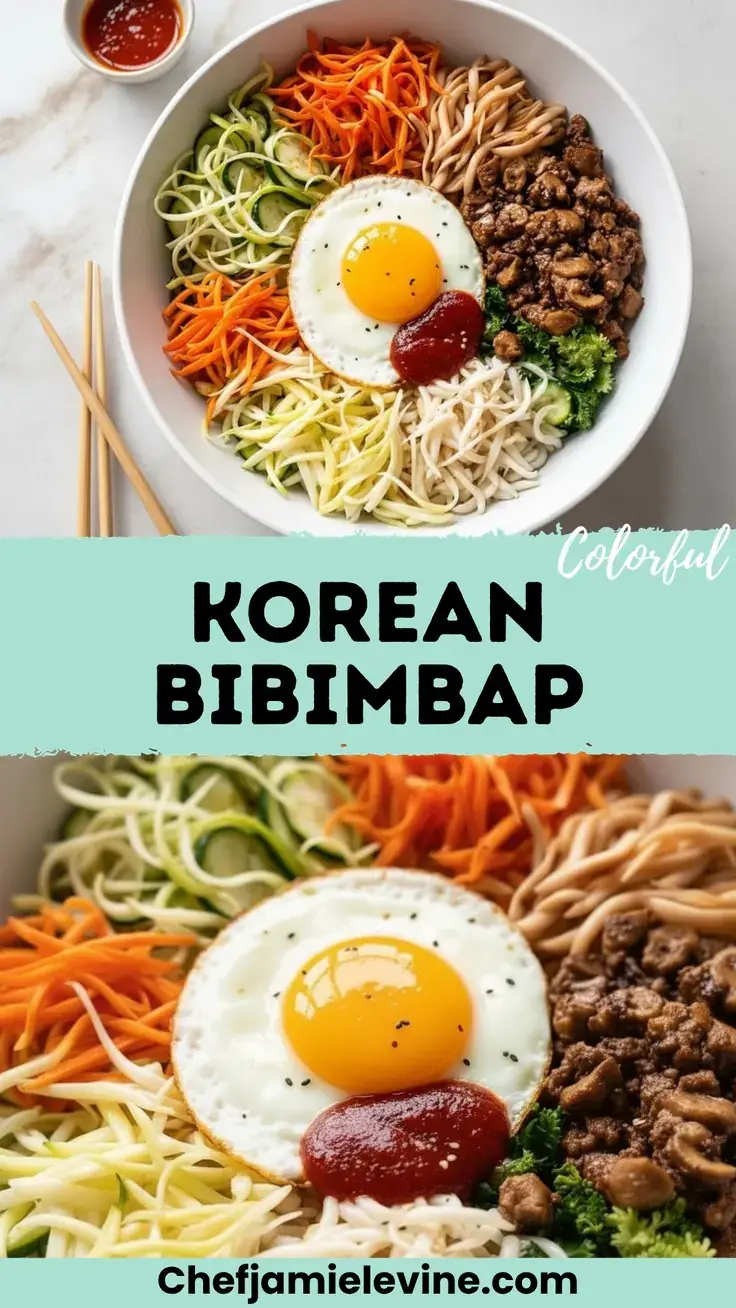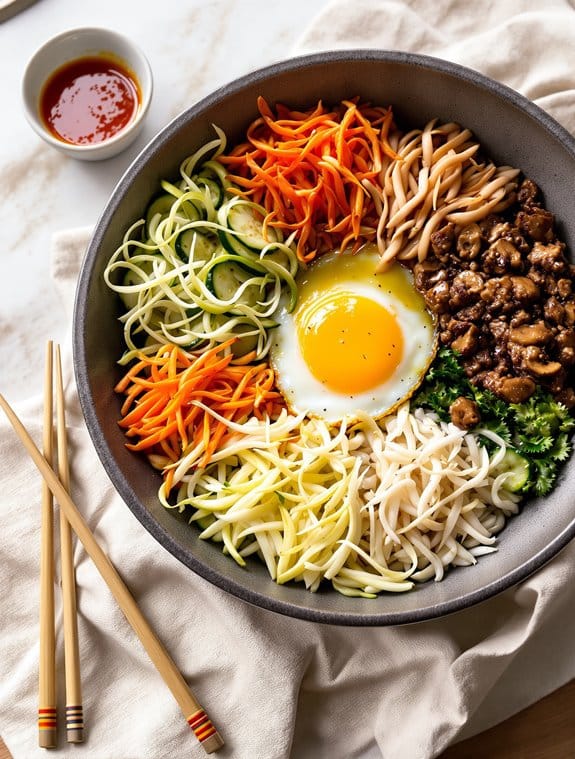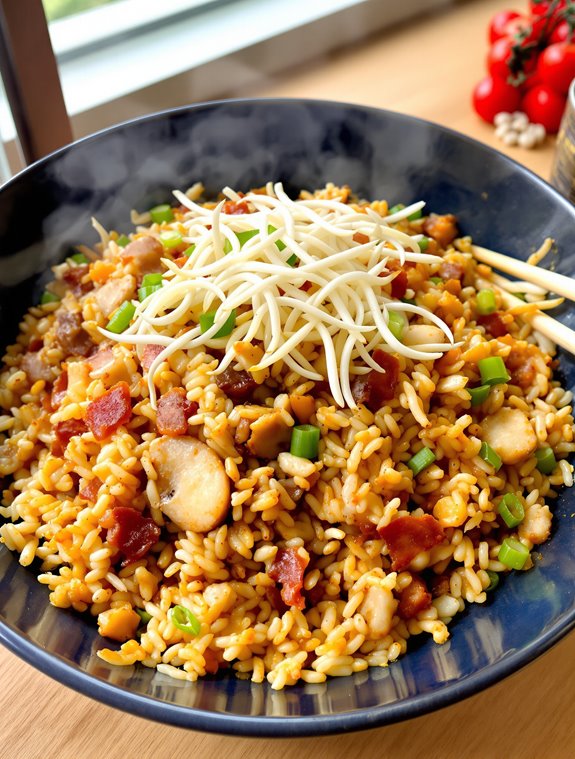Why You’ll Love this Authentic Korean Bibimbap
There are three reasons you’ll love this authentic Korean bibimbap. First, it’s incredibly customizable—with beef, eggs, and a rainbow of veggies, you can adjust ingredients to suit your taste.
Second, the contrasting textures create a sensory masterpiece; crispy vegetables against tender beef, all topped with that perfectly runny egg yolk.
Third, the flavors are absolutely divine. The combination of sesame oil, garlic, and that spicy-sweet Korean chili paste creates a depth that’ll have you scraping the bowl clean.
Trust me, once you mix everything together, each bite becomes a little treasure hunt.
What Ingredients are in Authentic Korean Bibimbap?
Bibimbap, which literally means “mixed rice” in Korean, brings together a beautiful array of ingredients that create a perfect harmony of flavors and textures. The foundation is a bed of short-grain rice topped with carefully prepared vegetables, seasoned meat, and that signature runny egg that ties everything together when broken and mixed.
What makes bibimbap special is how each component maintains its distinct flavor while contributing to the overall dish.
- 1 cup short-grain rice
- 1/2 pound lean ground beef
- 2 eggs
- 1/2 zucchini, thinly sliced
- 1 cup mushrooms, thinly sliced
- 1/2 cup bean sprouts
- 1/2 cup carrots, julienned
- 2 tablespoons soy sauce
- 3 tablespoons sesame oil
- 2 teaspoons sugar
- 1 garlic clove, minced
- 1/2 teaspoon grated ginger
- 1/2 cup apple juice
- 1/4 cup Korean chili paste (gochujang)
- 2 tablespoons rice wine vinegar
When shopping for these ingredients, the Korean chili paste (gochujang) might require a trip to an Asian grocery store or the international aisle of a well-stocked supermarket, but it’s absolutely worth seeking out—there’s really no substitute for its unique sweet-spicy flavor profile.
The quality of your vegetables matters too; try to find the freshest produce possible since they’re served relatively simply.
And while the recipe calls for ground beef, don’t hesitate to substitute with thinly sliced beef if you prefer a more traditional approach, or even tofu for a vegetarian version.
How to Make this Authentic Korean Bibimbap

Making bibimbap is all about preparation and layering. Start by marinating 1/2 pound of lean ground beef in a flavor-packed mixture of 2 tablespoons soy sauce, 1 tablespoon sesame oil, 2 teaspoons sugar, 1 minced garlic clove, 1/2 teaspoon grated ginger, and 1/2 cup apple juice. Let those flavors meld while you cook 1 cup of short-grain rice according to package directions—this will form the foundation of your bibimbap bowl.
Now comes the fun part: preparing each component separately to maintain their distinct textures and flavors. In a skillet, heat 1/2 tablespoon of sesame oil and sauté 1/2 zucchini (thinly sliced) until tender, about 5 minutes, then set aside.
Using the same technique, sauté 1 cup of thinly sliced mushrooms in another 1/2 tablespoon of oil. Meanwhile, blanch 1/2 cup of bean sprouts in boiling water for just a minute—we want them crisp-tender, not mushy.
Brown the marinated beef in the same skillet you used for the vegetables (no need to add more oil), breaking it up as it cooks. Finally, heat the remaining tablespoon of sesame oil and fry 2 eggs until the whites are set but the yolks remain gloriously runny.
To assemble, mound half the rice in the center of a large bowl and artfully arrange half portions of the zucchini, mushrooms, bean sprouts, and 1/2 cup julienned carrots around the outside. Sprinkle half the beef over the vegetables and crown your creation with a fried egg.
Serve with 1/4 cup Korean chili paste (gochujang) and 2 tablespoons rice wine vinegar on the side, allowing diners to add to taste. The magic moment comes when you break that egg yolk and mix everything together, creating a harmonious blend of flavors and textures in every bite.
Repeat with remaining ingredients for a second serving, or save components separately for later.
Authentic Korean Bibimbap Substitutions and Variations
While the classic bibimbap recipe I’ve shared is traditional, you’ll be happy to know that this Korean dish welcomes creative adaptations based on what’s in your fridge or dietary needs.
Don’t have short-grain rice? Brown rice or quinoa work beautifully.
Vegetarians can skip the beef and double up on mushrooms or add firm tofu.
No Korean chili paste? Sriracha mixed with a touch of miso makes a decent substitute.
I’ve even made mine with leftover roasted veggies when I’m too tired to prep fresh ones.
The real magic happens when you mix everything together, creating that perfect balance of textures and flavors.
What to Serve with Authentic Korean Bibimbap
Though bibimbap is a complete meal on its own, serving it alongside traditional Korean side dishes elevates the dining experience to restaurant quality.
My favorite accompaniments include kimchi (that fermented cabbage with the perfect kick), crisp cucumber namul, or spinach tossed with sesame oil.
For beverages, I’ve found that barley tea (boricha) cuts through the richness perfectly, or try makgeolli, a milky rice wine that complements the flavors beautifully.
Sometimes I’ll whip up a quick doenjang jjigae (soybean paste stew) for those extra hungry nights.
Final Thoughts
Beyond those perfect pairings, bibimbap has become my go-to meal when I want something both nourishing and exciting.
There’s something magical about breaking that runny egg yolk and watching it coat the colorful vegetables and savory beef. The textures and flavors dance together in a symphony that’s hard to beat.
I’ve made this recipe countless times, sometimes with whatever veggies are languishing in my fridge.
The beauty of bibimbap? It’s endlessly adaptable. Whether you’re cooking for one or hosting friends, this Korean classic delivers comfort and satisfaction in every bowl.
Worth every minute of prep, I promise.

Korean Bibimbap
Ingredients
Equipment
Method
- Cook the short-grain rice according to package directions and set aside.
- In a bowl, combine ground beef, soy sauce, 1 tablespoon sesame oil, sugar, minced garlic, grated ginger, and apple juice. Let marinate while preparing other ingredients.
- Heat 1/2 tablespoon sesame oil in a skillet over medium heat. Sauté zucchini until tender, about 5 minutes. Remove and set aside.
- In the same skillet, heat another 1/2 tablespoon sesame oil and sauté mushrooms until browned. Remove and set aside.
- Blanch bean sprouts in boiling water for 1 minute, then drain and set aside.
- Cook the marinated beef in the same skillet until browned and cooked through, breaking it up as it cooks. Remove and set aside.
- Heat the remaining tablespoon of sesame oil in the skillet and fry eggs until whites are set but yolks remain runny.
- To assemble each bowl, place half the rice in the center of a bowl. Arrange portions of zucchini, mushrooms, bean sprouts, and carrots around the rice. Top with half the beef and a fried egg.
- Serve with Korean chili paste (gochujang) and rice wine vinegar on the side, allowing diners to add to taste before mixing everything together.



